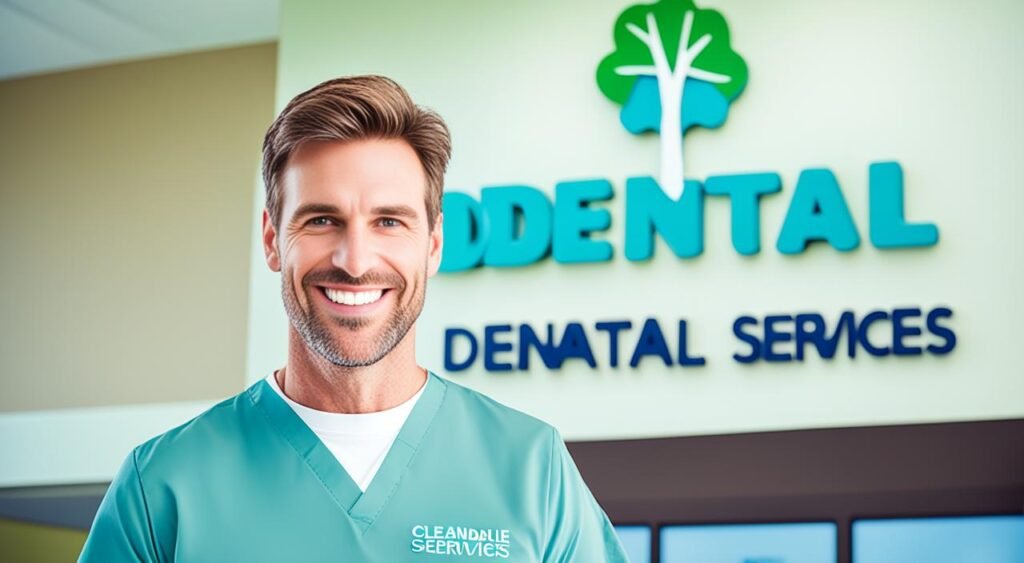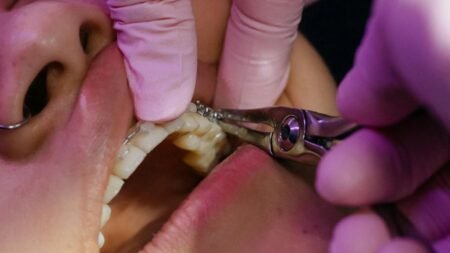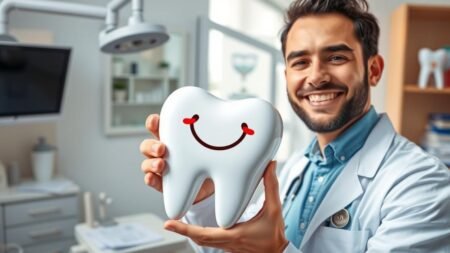Did you know that a shocking 130 million Americans lack dental insurance, leading to an unknown number of them struggling with the high costs of dental services? If you’ve found yourself among this number, you’ve likely asked the question: “Is dental free in USA?”
In the complex world of health and dental care in the United States, finding affordable dental care and accessible dental services can seem like an uphill battle. But don’t worry, this article will guide you through the various factors that influence dental costs, options for free or low-cost dental services, and how to navigate the intricacies of dental insurance. Let’s jump right in and start unraveling the mysteries of dental costs in the USA.
Key Takeaways
- 130 million Americans don’t have dental insurance, greatly affecting their ability to afford dental care.
- The complex system of healthcare and dental services in the USA often leads to confusion about costs and options for care.
- Understanding the cost of dental procedures and the factors that influence them is critical in seeking affordable dental care.
- Free or low-cost dental care services are available in the USA, but their accessibility and applicability may vary depending on individual circumstances.
- Dental insurance, both public and private, can significantly reduce dental care costs and are explored further in the article.
Understanding Dental Care in the U.S. System
When discussing dental services in the USA, one must comprehend how inherently complex and diverse the dental care system is. This understanding starts with the structure of dental services and then moves towards analyzing the differences between public dental programs and private dental care. Let’s dive deep.
The Structure of Dental Services
A majority of the dental services in the USA are offered by private practices. These services are broadly divided into two categories: General and Specialized services.
- General services typically include routine check-ups, teeth cleaning, fillings, extractions, and root canals.
- Specialized services involve care provided by specialized dentists such as orthodontists, periodontists, and oral and maxillofacial surgeons. These services include braces, gum disease treatment, and surgeries, respectively.
This division is not concrete, as many private practices offer specialized services depending on the additional training of the dentist in charge.
Public vs. Private Dental Care
The dental care system in the United States is characterized by a blend of public dental programs and private dental care options, each having its pros and cons.
| Aspect | Public Dental Programs | Private Dental Care |
|---|---|---|
| Quality | Variable, dependent on funding and resources | Often high, with access to the latest technology and techniques |
| Cost | Often free or low cost | Can be expensive without insurance |
| Accessibility | Limited, typically aimed at low-income families, seniors, children, or veterans | Widely available to anyone who can afford it |
Despite the stark contrasts, both public and private dental care play significant roles in maintaining the dental health of U.S. residents. The choice ultimately depends on an individual’s budget, accessibility, and personal needs.
Is Dental Free in USA?
The common conception that healthcare – including dental care – is never cost-free in the USA, often makes people wonder: Can one actually get free dental services or check-ups? The answer is not exactly black and white.

While national healthcare policies do not guarantee completely free dental care to all citizens, it is indeed possible for certain individuals under specific circumstances to access free dental services. There are governmental and non-profit programs designed to offer free or low-cost dental treatments for qualifying individuals. However, these services often come with certain criteria that need to be met.
Free dental check-ups, for instance, are often available through local dental clinics or universities with dental programs. These set-ups allow dental students to gain experience under the oversight of professional teachers, in turn providing free check-ups and basic services to the public.
- State and local health departments: Some states have dental programs offering free or reduced-cost dental services.
- National health events: National health observance events like National Children’s Dental Health Month, and others sometimes provide free dental services.
- Community health clinics: Community health centers funded by federal grants offer free or reduced-cost medical and dental services.
However, one should take note that while these services help make dental care more accessible, they do not necessarily mean that dental care is entirely free in the USA. There’s often a waiting list for these services, given the high demand and limited resources. And even when one does avail these services, there might be hidden costs associated with them.
Understanding how these systems work is key to accessing free or affordable dental care effectively. There might be navigational challenges or bureaucratic red tape involved. Information is power and arming yourself with the right understanding of these systems can go a long way towards securing accessible, low, or no-cost dental care.
Free Dental Services: Who Qualifies?
In the quest for reducing dental costs, an essential understanding is required about the eligibility for free dental services, which varies based on federal and state programs. These programs are designed to provide indispensable dental cost assistance as well as free dental care programs, aimed at aiding varying demographics.
Federal Programs for Dental Care
The U.S. federal government has launched various initiatives to lower dental care expenditures for the citizens. Prominent programs include the Children’s Health Insurance Program (CHIP) and Medicaid. Both of these provide substantial dental cost assistance to eligible individuals, primarily targeting low-income families and children.
State-Sponsored Dental Assistance
Speaking of state dental assistance, numerous states organize free or low-cost dental clinics for their residents. The specific services offered and the exact eligibility criteria vary by state. However, typically, these programs are designed for low-income families, the elderly, or the uninsured.
Special Groups and Free Dental
There are special groups that can get free dental care or substantial cost reductions on their dental treatments. Children with special needs, pregnant women, senior citizens, veterans, and homeless individuals are some of the categories that can benefit from these programs. Many charitable organizations and national associations offer such targeted free dental care programs, contributing a significant role in providing needy people with affordable oral healthcare.
It’s always worth checking what assistance you are qualified for, as these initiatives can make a significant difference in managing your dental costs. Stay informed and proactive in your pursuit for affordable dental care.
Affordable Dental Care Solutions
In the quest for affordable dental care, your options are more diversified than you might imagine. Accessible dental services are within reach if you know where to look and what to consider. Here, we explore several attractive avenues to securing the quality dental care you need at a price you can afford.
Firstly, payment plans offered by many dental practices can help ease the burden of cost. Rather than paying a large, upfront fee, payment plans allow you to spread the cost of your treatment over a longer period, making dental care more manageable financially.
Secondly, you might want to explore negotiated fee schedules. This involves negotiated payment rates between the dental care provider and the patient, which can often result in reduced costs for you.
Consider also, dental savings plans. These are membership-based services where you pay an annual fee to access lower rates from participating dentists. The savings can be significant, especially for more expensive treatments.

| Options For Affordable Care | Description |
|---|---|
| Payment Plans | Allows you to distribute the cost over a specified period, making fees more manageable. |
| Negotiated Fee Schedules | Enables dentists and patients to agree on reduced rates for dental services. |
| Dental Savings Plans | Membership-based services offering lower rates from participating dentists for an annual fee. |
As you can see, there are several ways to obtain more accessible dental services without sacrificing the quality of care. However, it’s essential to always do your research, identify your specific needs, and approach your dental care proactively. Remember, the goal is not only to find affordable dental care but to ensure that it’s the right care for you.
Dental Insurance Options in the USA
In the United States, dental insurance can play a critical role in accessing professional dental services without incurring prohibitive out-of-pocket costs. Let’s look at various dental insurance options available to U.S. residents, starting with employer-provided plans.
Employer-Provided Dental Insurance
Many employers in the U.S. offer dental insurance as part of their employee benefit package. Coverage and costs differ from one company to another, but these plans typically cover preventive and diagnostic care and partially cover major procedures. It’s essential to understand the extent of your employer-provided dental insurance plan to maximize your benefits.
Private Dental Insurance Plans
Procuring Private dental insurance plans independently can be a suitable option if your employer doesn’t offer dental insurance or if you’re self-employed. These plans usually include different levels of coverage and have varying cost structures. It’s paramount to understand what is and isn’t covered before purchasing any plan.
Medicaid Dental Coverage
For low-income individuals and families, Medicaid dental coverage can be a viable option. Medicaid typically covers essential dental services but the extent of coverage can vary among different states. It’s essential to check with local state Medicaid programs to understand your potential coverage better.
In conclusion, understanding and carefully weighing these dental insurance options could significantly ease potential financial burdens related to obtaining professional dental care, and ultimately contribute to better oral health.
Conclusion
In the exploration of dental care costs in the United States, one thing becomes apparent: the landscape can be complex and daunting. Whether you’re searching for free dental care programs or devising pragmatic strategies for dental cost assistance, the process can sometimes feel overwhelming.
Just as diverse as our dental needs are, so are the myriad solutions available to cater to them. The availability of free dental care significantly varies across different demographics, with federal and state programs stepping in to provide relief for those with limited resources. For others, affordable dental care or dental insurance options source their dental needs.
Ultimately, the goal is to ensure we all can smile confidently – both at the dentist’s office and when reviewing our bank statements. Therefore, it is integral to thoroughly reflect upon your specific needs and circumstances and make informed decisions that thoughtfully consider all the options at your disposal. This comprehensive review of how the U.S. dental system works serves to arm you with the essential knowledge to traverse the complexities associated with receiving quality dental care without incurring unsustainable costs.
Here’s to your sustained dental health and a system that supports it!
FAQ
Is dental care free in the USA?
Not typically. While there are some free dental services available, they are generally offered to low-income individuals, children, seniors, or those with certain qualifying factors. For most Americans, dental care has associated costs which can vary depending on several parameters.
What are the differences between public and private dental care in the USA?
Public dental care, funded by government programs like Medicaid, is often limited and might offer fewer services than private care. Private dental care, on the other hand, usually provides a broader range of services but at higher costs. It’s essential to understand the benefits and downsides of both before making a decision.
How can I qualify for free dental services?
Eligibility for free dental services can depend on various factors like income level, age, military status, and coverage through certain public assistance programs. Each program has its own set of qualifying criteria, which can be found on their respective websites.
What solutions are available for affordable dental care?
Options for affordable dental care include negotiating a payment plan with your dentist, joining a dental savings plan, attending dental school clinics, utilizing low-cost clinics, or using dental cost calculators to estimate expenses.
What dental insurance options are available in the USA?
Dental insurance options include employer-provided dental insurance, private individual dental insurance plans, and Medicaid for those who are eligible. Each of these options varies in terms of cost, coverage, and accessibility.
Are there any dental cost assistance programs?
Yes, both federal and state programs offer dental cost assistance, including Medicaid and the Children’s Health Insurance Program (CHIP). Non-profit organizations and dental schools might also provide assistance or reduced-cost services.








